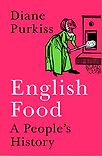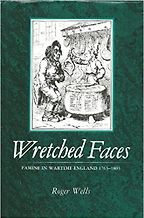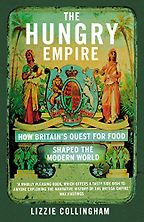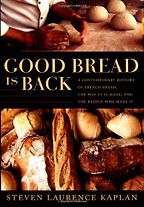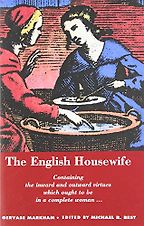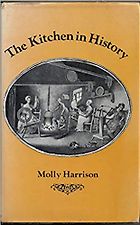Thank you for these very interesting book recommendations on the history of food. How did you first become interested in this subject?
It happened through other projects. Firstly, through the work I’ve done on witchcraft. Secondly, through the work I did on the English Civil War. Both of those projects were about trying to get beyond the intellectual history-type position, where the Civil War was caused by people having a rational response to autocracy, and witchcraft trials were caused by people not being sufficiently post-Enlightenment.
I really dislike that kind of historical approach, because it’s completely untrue to the way people behave. I mean, how rational is our current government, I ask you? In many respects, other things that were perhaps a bit more primal were probably at stake.
And I uncovered quite an interesting riff, I guess, in English Civil War history, which was a preoccupation with food, and with writing cookbooks, and with expressing political views through cookbooks. That, for me, intersected with the fact that a lot of witchcraft accusations are actually caused by food shortages, in quite a straightforward way. One of the things that they reportedly do, that upsets their neighbours, is spoil food production—like, you’re making butter, the witch comes into the room, and—by some kind of undefined negativity—makes your butter fail to set. Then you’ve wasted the expensive primary ingredient, cream, which you can’t just go down to the shop and replace.
So that kind of story about marginal subsistence and starvation got me really interested in food history. Which I thought was dispiritingly top-down.
What do you mean by that?
Most food history is about banquets. In thirty years’ time, when people read the food history of now, they will hear all about the coronation quiche, notwithstanding the fact that it doesn’t really represent a current food trend. Some people will loyally go ahead and make it, but it’s not really a good sampling of 2023 food culture. So I was interested in whether there was another way. I decided to go beyond cookbooks—because most food history is really based on recipe books—to sources for what people were actually eating, and how they were cooking.
There are two kinds of food historians. Ones who try out the recipes, and the ones who just copy them down. I’m the first kind. So I got really interested in how very few of us there are—there are honourable exceptions. Others will study without ever making their own bread or their own jam, or trying anything out themselves.
That sounds fun. Was it fun?
Yes, actually too much fun, which is one reason why it took me ages. It’s also an inexhaustibly large topic, even confined just to England. My first draft was twice the length of the book actually published. And even so, the book is long, isn’t it?
But the interesting thing to me was that it isn’t like most other history, which is like writing a novel—this happens, then that happens because of this. In food history, you can’t connect things up like that. Things mysteriously appear and then disappear. I came to find that interesting, and learned to live with it.
Let’s have a look at these food history books that you’ve selected, starting with The Kitchen in History by Molly Harrison. Could you give us an overview, and why you think it’s worth reading?
Weirdly, a lot of food history ignores food preparation, and particularly the material needs of food preparation. There are only a small number of books that focus on the kitchen and utensils, but they’re very important in terms of what you can and can’t cook. The main reason people choose the foods they do is material. So: Do you own a cake tin? Do you have enough resources to get an oven hot enough to bake a cake? Have you heard of cake? I chose this book because it’s one of the best accounts of the way we eat and how that is shaped by what we have and what we inherit in the way of equipment and expectations.
I have a story that explains this, although it’s not from the book. I had an acquaintance, who used to be senior in the Food Commission. She taught an adult cookery class in England, and at the end of the course, she said to the women: ‘To celebrate we will make a cake next week, so everyone remember to bring in a tin.’ Nothing more than that. The next week, they all came in with their idea of a tin. One brought a beer can, another brought a washed-out tin of sardines. They didn’t really know what a cake tin was, nor did they have the money to go and buy one. This was only in the 1990s.
It just perfectly illustrates the fact that our food horizons are shaped by materiality. That was inspirational for me while researching and writing my book.
Before our interview began, you said something interesting about how food history is not really about the food. It’s what the food says about those making or eating it. So I guess we are looking at food as a proxy for other social forces or social factors. Did I get that right?
Absolutely. Right. It’s interesting that the kitchen is a gendered space. Even in a world of male master chefs, it’s still a feminised space, a space where women are allowed to dominate. It’s marked off as this space that you’re allowed to have. But there’s something confining about that too; it can come to seem like a prison, something you’re stuck with. So we make massive efforts to turn it into a social space. We eat in the kitchen, or make it open plan—make it less like a trap. But in actuality, most women probably still feel there’s some kind of inner super-ego inspector who’s in charge of assessing whether they’ve done a good job of Christmas dinner, or a good job with the birthday cake.
I do find it interesting that there has been a rise in ‘housekeeping’ influencers: aspirational cooking, cleaning, folding, tidying, and interior decorating accounts with hundreds of thousands—even millions—of followers. There have been many recent bestselling books on the subject of homemaking, fortunes made. And largely marketed to women. So I sense it as a social pressure still, although my own home life is not particularly traditional.
I think that’s right. And I think it’s uncomfortable because, in my view, domestic labour still isn’t arranged in an egalitarian way in the majority of households. Cooking is often something women are supposed to do. You could be like my own mother, and find it deeply boring; she was from a generation where cooking was meant to be thrilling and exciting. You were meant to be inventive with it. But she was one of those people who felt trapped in a kitchen.
Let’s move on to your next book recommendation, which is Roger Wells’ Wretched Faces, a history of famine in England. Could you tell us more?
This is one of two books that really changed my approach to the whole subject of food. Because most books about the history of food focus on what the rich eat—just like most histories of fashion focus on that tiny one percent of society. And that’s fine, if you recognise that it’s all a daydream. But it doesn’t give you a good holistic picture of what the past was actually like.
We tend to assume, historically, that people’s standard of living and life expectancy just goes on improving on a steady upward trajectory. But this was really not the case. Wretched Faces exemplifies why that was: there was an absolute disaster, demographically, at the beginning of the 19th century, where you had extraordinarily widespread rural poverty, mostly because of the Corn Laws—which were imposed during the Napoleonic War to restrict imports, and kept the price of wheat very high—but partly because of continuing subsistence agriculture and the ongoing Little Ice Age.
What people want is wheat, which is always marketable, always successful as a commodity, but it’s not successful as a gardening product. If you have a wet summer, the wheat will just rot in the field and you’ll have a horrendous and upsetting shortage, in which people are starving almost immediately. This was still a period where most people were living harvest to harvest. If the harvest is rubbish, or prices rise to the level where people can’t afford bread, then there’s nothing else to eat except potatoes. Then you get the potato blight. I was really struck by the fact that, ten miles from where I live, people were literally starving to death as late as the 1840s. That’s something we—perfectly reasonably—associate with what the Irish call ‘the Great Hunger’. But it wasn’t much better here in England, and there were the same kind of economic forces—land being used to grow cash crops, and the exploitation of labour. If you look at 19th-century food history, however, it won’t be about women living on slices of bread with a scrape of jam three times a week.
Your latest publication is English Food: A People’s History. I found it interesting that you are a professor of English literature, but you write history books.
My undergraduate degree was dual English and History. In various ways, so was my doctorate. The short answer is that teaching English literature is really interesting, because the answer is always different, while in history a thorough look at what’s available to you could lead you to the same answer every time. I find that less interesting than teaching Shakespeare.
But I find history more interesting to research than English literature. There’s not really a lot of research in English literature. You can work on manuscripts in English literature, and that can get really interesting. But, actually, the interesting research in literature is really historical research—it’s just pretending not to be.
“The openness and plurality of food culture is an uncomfortable but ongoing reminder of the importance of empire”
I find the narrowness of individual ‘subjects’ defeating. You bring more to reading poetry, I think, if you have a strong sense of what they are likely to have had for dinner. We mustn’t underestimate the shaping power of what we eat. I’ve been doing some work recently on the English at sea, and thinking about scurvy. The effects of scurvy on the mindset of entire naval armadas is almost impossible to overestimate. That’s the remarkable thing. People were literally dying in droves of a disease that nobody fully understood right up to polar exploration.
I mean, it’s a horrible illness. Not only is it physically incredibly painful, and unbelievably exhausting—like a dreadfully bad Covid—but the worst thing about it is that healed wounds open up again. So it has this spectral quality in a military outfit. The leg that got shot suddenly reopens and starts bleeding again. Things like that.
When you think about food in those terms, and the likely effects… I mean, until the 19th century, the majority of people in England, for example, didn’t get enough protein and fat. That will have affected everything: their brain development, their ability to make decisions, their energy levels, everything. So the top-of-our-body stuff, the things history tends to prioritise, is really contingent on the lower-body stuff that we often brush aside. We can only do that from a position of privilege.
That discussion of scurvy might have led us quite neatly to Lizzie Collingham’s The Hungry Empire, a study of British imperial history structured around twenty recipes. It was first published under the title Tastes of Empire.
I think I do dare to misquote Kipling and say: What do we know of English food, who only English food know? This is a country where the national drink comes from a plant that won’t grow here: tea. It’s flavoured by another plant that won’t grow here: sugar. (Sugarcane, not sugarbeet—sugarbeet is mostly German, and didn’t get going until the nineteenth century, a long time after our sweet tooth established itself.) English food culture is contingent on our status as a mercantile empire power. The food culture we live in now is one where people identify a stir fry, or chicken tikka masala, as their favourite dish. Most people know what sushi and ramen are.
The openness and plurality of food culture, especially in towns and cities, is an uncomfortable but ongoing reminder of the importance of empire. And the converse of that, of course, was why we nearly starved to death in both world wars. We were a week away from starvation in World War One due to bad planning, and it was only relentless planning in the Second World War that saved us.
Five Books interviews are expensive to produce. If you're enjoying this interview, please support us by donating a small amount.
It’s interesting that the food revolution in Britain has been modelled on food cultures of France, Italy, Iberia: it’s all about the local, the local cheeses, breads, growers. That’s lovely, I’m not against it. But one reason it hasn’t percolated far down the food chain—we still eat more ultra-processed food than any other country in Europe—is because it’s inimical to the food culture we’ve historically tended to have, which is creolized dishes of the kind highlighted in Collingham’s book.
That book is a wonderful introduction to, in a way, the irrelevance of trying to build for ourselves belatedly the culture that Elizabeth David thought we should have, rather than embracing what we’re actually good at, which is grabbing and reinventing things brought here by other people. Fish and chips is the English national dish, but it’s not English—it’s a weird mishmash of a Jewish dish—where they serve the fish cold—and an Irish potato leftovers dish. So: not English. I think what I’m trying to say is that what we mean by Englishness needs to be redefined. Not as mince and mashed potatoes, but as a willingness to taste and try.
What you’re saying about food reflecting something of the national consciousness also ties in with your next book recommendation, which is Good Bread is Back: A Contemporary History of French Bread by previous Five Books interviewee, Steven Kaplan.
I just love this book, and I love all his work. I keep banging on about how overrated Elizabeth David is in food history, but David writes—in English Bread and elsewhere, that French cuisine has been something so sacred that it’s just inevitably marvelous. But, actually, Good Bread is Back goes firmly against that narrative, because it’s the story of Kaplan’s efforts to save the baguette from industrial bakers. It led to an actual piece of legislation called l’ordinance Balladur which put in place the criteria for what a baguette could and could not contain. That’s now recognised by Unesco World Heritage. But it wasn’t before Kaplan’s intervention as an American in Paris; the French had been perfectly willing to allow the baguette to run downhill and become a much more ultra-processed kind of bread than we think is good nowadays.
That’s very interesting. Because so much of the identity of France, at least to an outsider, seems to be tied up in the boulangerie.
That’s right. Although it depends on the boulangerie. There’s a chain called Éric Kayser boulangeries—I think there are more than twenty now—which all craft a thing called the baguette Monge or sometimes the baguette tradition, which uses what the French call ‘old dough’ as the basis for the fermentation. So there’s an element of sourdough. But virtually every other grocery will be selling something pretty indistinguishable from what is sold in upmarket supermarkets over here. And if you go to Carrefour, or somewhere like that, you will smell the fresh bread, but it will be what’s called ‘bake off’ in the trade—it’s also called the ‘Milton Keynes process’ that produces the dough, hilariously—essentially they just push a lot of additives into it. It qualifies as an ultra-processed food because of the enormous amount of gluten it contains, and the preservatives, the stabilisers, the fat… it can just about be sold as ‘bread’, but you’re not supposed to sell it as a ‘baguette’.
But it’s wonderful in places, and you can also get fantastic bread in Britain now. But around 90% of the bread flour sold in Britain is augmented with high gluten flour from the Canadian wheat belt. The average gluten content of a loaf made in the 19th century would have been around eight or nine percent. Now, that’s more like eleven to fourteen percent. If you use low-gluten flour, you have to put way more time into baking, spend longer kneading it, give it longer periods of rest, a much longer rise. It’s a much heavier workload for the baker.
Basically, Canadian wheatbelt flour is a shortcut. And like all shortcuts, it has its disadvantages. It’s been argued that the higher gluten content is one of the reasons that we’re seeing so much celiac disease and so much gluten intolerance. People’s systems have just been overloaded with gluten that they are not genetically equipped to handle—in the way that many Asians can’t tolerate dairy.
Where I live, we have issues growing wheat due to the climate. We have a local type of barley called ‘bere’ which is very hardy but quite rough. You can cook with it, but better to bake those flat scone-like breads.
Bannocks, yes. That’s very standard. It’s what cake used to be. The cake started as a bannock, and our idea of something puffy and sweet is very recent. It was basically something crisp and kind of hard. There’s also an interesting argument as to whether that’s when our teeth went bad.
I think we’ve come to your final history of food book recommendation. This is The English Housewife by Gervase Markham, dating from 1615.
This is at least partly a work of fantasy; it’s Markham’s idea of how a household ought to be run, rather than what anyone actually did. Nonetheless what it reminds us of is the attenuated role of the modern housewife in comparison with what it used to be. It used to be like running a small business—you might typically have a staff of between five and five hundred people working for you to manage. And what Markham really clarifies is just how much knowledge this involved.
If you wanted to ever have fruit, you had to be acting to preserve every tiny scrap of it. They’re preserving not only peak, ripe, glossy apples, but gathering up what they call the greenings, the windfalls that dropped before they were ripe. There are dozens of uses for those—you can make them into a kind of vinegar for salad dressing, or into a relish, or into a sugar paste as a dessert. All this thinking and planning and oversight is hugely interesting. It wasn’t like the weirdness of being a housewife in the 1950s, where inessentially you were confined to a tiny, not very interactive, space. It was more like running an enterprise of reasonable size.
Given that, I can see that, if one were an ambitious 17th-century merchant, say, it would be very important to have a capable wife running the show at home.
Among other things, she would need to be a shrewd bargainer, who could manage her own time and everyone else’s. She would assign tasks to people according to their skills, provide training for people coming through. It’s extraordinarily sophisticated.
The reason I say this, is that we’re often rude about the past, and its food ideas. As if they were somehow just grovelling around on a muck heap. Sometimes people will casually say: ‘This brings us back to the Middle Ages.’ I’m like: ‘You wish! You don’t have the skills to survive in the Middle Ages. Tell me about your crop rotation plan.’ Just look at the number of physically demanding tasks that had to be performed by an ordinary yeoman, his wife, and the rest of his household. It’s gobsmacking. So we should always have respect for the people who did that, even if they didn’t do it in the ideal way environmentally, or in terms of animal welfare. Don’t forget that they were the people who were getting up at five in the morning—or three in the morning if they are bakers—to make sure the rest of us can eat.
Interview by Cal Flyn, Deputy Editor
May 12, 2023. Updated: May 14, 2023
Five Books aims to keep its book recommendations and interviews up to date. If you are the interviewee and would like to update your choice of books (or even just what you say about them) please email us at [email protected]

